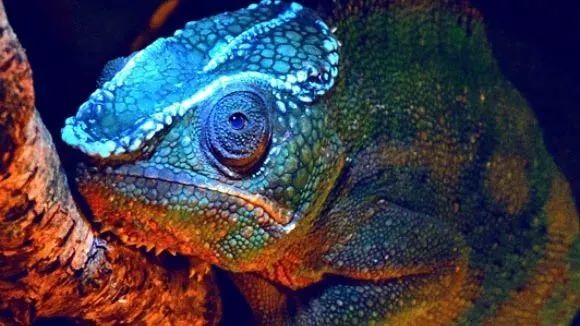
The chameleon under ultraviolet light has a special blue, this color comes from-- bone!
chameleons are best known for their bright and varied body colors. Now, people have another understanding of the color of the chameleon: under ultraviolet light, many chameleons emit blue fluorescence:
fluorescence is not uncommon in the biological world. but the chameleon's blue fluorescence has an unusual source: it actually comes from bones.
scientists have known that bones have fluorescence before, and this phenomenon is also used in forensic research. However, because of the barrier of multiple layers of soft tissue, the fluorescence of bones is generally completely invisible in animals. But the situation of the chameleon is different. Their skulls have many protruding nodules, and tissue sections show that there is only a thin layer of epidermis covering these nodules. As a result, the positions of these nodules form small "windows" so that the fluorescence produced by the bones can be seen from the body surface.
(bone bulges covered only with very thin epidermis)
these unique "skeletal fluorescence" are mostly found in species living in the rainforest, and there are differences between the sexes. The researchers speculate that these fluorescent patterns may become another visual communication signal in addition to body color. The chameleon's vision is more suitable for short-wave light (350u2009nm-650u2009nm), and these blue lights may be clearer in the chameleon's eyes. And this fluorescence should be relatively easier to see in the shadow of the rainforest than in direct sunlight. The differences between the sexes suggest that there may also be a factor in sexual selection.
Desiring to be the Belle of the ball with top quality yet low priced empire style wedding dresses? Don’t waste your time and money at overpriced retailers – we are here for you.
anyway, it sounds so cool to see the bone glowing through the epidermis.
Source: http://blogs.discovermagazine.com/d-brief/2018/01/17/chameleons-glow-uv-light/#.WmAMvqiWbIV
original thesis: https://www.nature.com/articles/s41598-017-19070-7